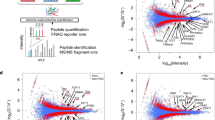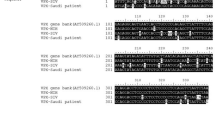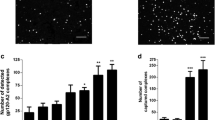Abstract
African monkeys are resistant to HIV-1 infection due to intrinsic restriction mechanisms found in their cells. However, although they can be infected by monkey-adapted modified HIV-1 particles that are designed to overcome known restriction factors, virus numbers drop to undetectable levels in immunocompetent animals. These results indicate the possibility of the presence of yet unidentified factor(s) that restrict HIV-1 in old-world monkey (OWM) cells after integration of the viral genome into the host cell chromosome. In the light of these findings, we hypothesized that OWMs might have evolved resistance mechanism(s) against HIV-1 by switching specific gene(s) on in response to the synthesis of viral proteins in infected cells. In an attempt to mimic post-infection status, we expressed HIV-1 Tat gene in African green monkey cells and compared the whole proteome with normal cells and identified secretory leukocyte protease inhibitor (SLPI), a protein with known extracellular anti-HIV-1 activity, as an over-expressed protein in the presence of HIV-1 Tat protein by 2D-PAGE and mass spectrometry analysis. We also showed that overexpression of SLPI in the presence of HIV-1 Tat was specific to monkey cells. Our results also suggest that SLPI had a previously undiscovered intracellular anti-HIV activity in addition to its extracellular activity.






Similar content being viewed by others
References
McCarthy KR, Kirmaier A, Autissier P, Johnson WE (2015) Evolutionary and functional analysis of old world primate TRIM5 reveals the ancient emergence of primate lentiviruses and convergent evolution targeting a conserved capsid interface. PLoS Pathog. https://doi.org/10.1371/journal.ppat.1005085
Klatt NR, Silvestri G, Hirsch V (2012) Nonpathogenic simian immunodeficiency virus infections. Cold Spring Harb Perspect Med. https://doi.org/10.1101/cshperspect.a007153
Pepin J (2013) The origins of AIDS: from patient zero to ground zero. J Epidemiol Community Health 67(6):473–475. https://doi.org/10.1136/jech-2012-201423
Blanco-Melo D, Venkatesh S, Bieniasz PD (2012) Intrinsic cellular defenses against human immunodeficiency viruses. Immunity 37(3):399–411. https://doi.org/10.1016/j.immuni.2012.08.013
Stremlau M, Owens CM, Perron MJ, Kiessling M, Autissier P, Sodroski J (2004) The cytoplasmic body component TRIM5alpha restricts HIV-1 infection in Old World monkeys. Nature 427(6977):848–853. https://doi.org/10.1038/nature02343
Mariani R, Chen D, Schrofelbauer B, Navarro F, Konig R, Bollman B, Munk C, Nymark-McMahon H, Landau NR (2003) Species-specific exclusion of APOBEC3G from HIV-1 virions by Vif. Cell 114(1):21–31. https://doi.org/10.1016/S0092-8674(03)00515-4
Saito A, Akari H (2013) Macaque-tropic human immunodeficiency virus type 1: breaking out of the host restriction factors. Front Microbiol. https://doi.org/10.3389/fmicb.2013.00187
Hatziioannou T, Del Prete GQ, Keele BF, Estes JD, McNatt MW, Bitzegeio J, Raymond A, Rodriguez A, Schmidt F, Mac Trubey C, Smedley J, Piatak M, KewalRamani VN, Lifson JD, Bieniasz PD (2014) HIV-1-induced AIDS in monkeys. Science 344(6190):1401–1405. https://doi.org/10.1126/science.1250761
de la Fuente C, Santiago F, Deng LW, Eadie C, Zilberman I, Kehn K, Maddukuri A, Baylor S, Wu KL, Lee CG, Pumfery A, Kashanchi F (2002) Gene expression profile of HIV-1 Tat expressing cells: a close interplay between proliferative and differentiation signals. BMC Biochem. https://doi.org/10.1186/1472-2091-3-14
McNeely TB, Dealy M, Dripps DJ, Orenstein JM, Eisenberg SP, Wahl SM (1995) Secretory leukocyte protease inhibitor: a human saliva protein exhibiting anti-human immunodeficiency virus 1 activity in vitro. J Clin Investig 96(1):456–464. https://doi.org/10.1172/JCI118056
McNeely TB, Shugars DC, Rosendahl M, Tucker C, Eisenberg SP, Wahl SM (1997) Inhibition of human immunodeficiency virus type 1 infectivity by secretory leukocyte protease inhibitor occurs prior to viral reverse transcription. Blood 90(3):1141–1149
Py B, Basmaciogullari S, Bouchet J, Zarka M, Moura IC, Benhamou M, Monteiro RC, Hocini H, Madrid R, Benichou S (2009) The phospholipid scramblases 1 and 4 are cellular receptors for the secretory leukocyte protease inhibitor and interact with CD4 at the plasma membrane. PLoS ONE. https://doi.org/10.1371/journal.pone.0005006
Kuhmann SE, Platt EJ, Kozak SL, Kabat D (2000) Cooperation of multiple CCR5 coreceptors is required for infections by human immunodeficiency virus type 1. J Virol 74(15):7005–7015. https://doi.org/10.1128/Jvi.74.15.7005-7015.2000
Jensen FC, Girardi AJ, Gilden RV, Koprowski H (1964) Infection of human and simian tissue cultures with rous sarcoma virus. Proc Natl Acad Sci USA 52:53–59
Osada N, Kohara A, Yamaji T, Hirayama N, Kasai F, Sekizuka T, Kuroda M, Hanada K (2014) The genome landscape of the African green monkey kidney-derived vero cell line. DNA Res 21(6):673–683. https://doi.org/10.1093/dnares/dsu029
Dubridge RB, Tang P, Hsia HC, Leong PM, Miller JH, Calos MP (1987) Analysis of mutation in human-cells by using an epstein-barr-virus shuttle system. Mol Cell Biol 7(1):379–387. https://doi.org/10.1128/Mcb.7.1.379
Livak KJ, Schmittgen TD (2001) Analysis of relative gene expression data using real-time quantitative PCR and the 2(T)(-Delta Delta C) method. Methods 25(4):402–408. https://doi.org/10.1006/meth.2001.1262
Kondo M, Sudo K, Tanaka R, Sano T, Sagara H, Iwamuro S, Takebe Y, Imai M, Kato S (2009) Quantitation of HIV-1 group M proviral DNA using TaqMan MGB real-time PCR. J Virol Methods 157(2):141–146. https://doi.org/10.1016/j.jviromet.2008.12.006
Vroling AB, Konijn T, Samsom JN, Kraal G (2011) The production of secretory leukocyte protease inhibitor by dendritic cells. Mol Immunol 48(4):630–636. https://doi.org/10.1016/j.molimm.2010.11.002
Scott A, Weldon S, Taggart CC (2011) SLPI and elafin: multifunctional antiproteases of the WFDC family. Biochem Soc T 39(5):1437–1440. https://doi.org/10.1042/BST0391437
Geijtenbeek TBH, Kwon DS, Torensma R, van Vliet SJ, van Duijnhoven GCF, Middel J, Cornelissen ILMHA, Nottet HSLM, KewalRamani VN, Littman DR, Figdor CG, van Kooyk Y (2000) DC-SIGN, a dendritic cell-specific HIV-1-binding protein that enhances trans-infection of T cells. Cell 100(5):587–597. https://doi.org/10.1016/S0092-8674(00)80694-7
Ndung'u T, Renjifo B, Novitsky VA, McLane MF, Gaolekwe S, Essex M (2000) Molecular cloning and biological characterization of full-length HIV-1 subtype C from Botswana. Virology 278(2):390–399. https://doi.org/10.1006/viro.2000.0583
Coren LV, Trivett MT, Jain S, Ayala VI, Del Prete GQ, Ohlen C, Ott DE (2015) Potent restriction of HIV-1 and SIVmac239 replication by African Green Monkey TRIM5 alpha. Retrovirology. https://doi.org/10.1186/s12977-015-0137-9
Adachi A, Gendelman HE, Koenig S, Folks T, Willey R, Rabson A, Martin MA (1986) Production of acquired immunodeficiency syndrome-associated retrovirus in human and nonhuman cells transfected with an infectious molecular clone. J Virol 59(2):284–291
Igarashi T, Iyengar R, Byrum RA, Buckler-White A, Dewar RL, Buckler CE, Lane HC, Kamada K, Adachi A, Martin MA (2007) Human immunodeficiency virus type 1 derivative with 7% simian immunodeficiency virus genetic content is able to establish infections in pig-tailed macaques. J Virol 81(20):11549–11552. https://doi.org/10.1128/Jvi.00960-07
Saito A, Nomaguchi M, Iijima S, Kuroishi A, Yoshida T, Lee YJ, Hayakawa T, Kono K, Nakayama EE, Shioda T, Yasutomi Y, Adachi A, Matano T, Akari H (2011) Improved capacity of a monkey-tropic HIV-1 derivative to replicate in cynomolgus monkeys with minimal modifications. Microbes Infect 13(1):58–64. https://doi.org/10.1016/j.micinf.2010.10.001
Clark E, Nava B, Caputi M (2017) Tat is a multifunctional viral protein that modulates cellular gene expression and functions. Oncotarget 8(16):27569–27581. https://doi.org/10.18632/oncotarget.15174
Cantalupo PG, Saenz-Robles MT, Rathi AV, Beerman RW, Patterson WH, Whitehead RH, Pipas JM (2009) Cell-type specific regulation of gene expression by simian virus 40 T antigens. Virology 386(1):183–191. https://doi.org/10.1016/j.virol.2008.12.038
Li MM, MacDonald MR, Rice CM (2015) To translate, or not to translate: viral and host mRNA regulation by interferon-stimulated genes. Trends Cell Biol 25(6):320–329. https://doi.org/10.1016/j.tcb.2015.02.001
Jana NK, Gray LR, Shugars DC (2005) Human immunodeficiency virus type 1 stimulates the expression and production of secretory leukocyte protease inhibitor (SLPI) in oral epithelial cells: a role for SLPI in innate mucosal immunity. J Virol 79(10):6432–6440. https://doi.org/10.1128/JVI.79.10.6432-6440.2005
LaBonte JA, Babcock GJ, Patel T, Sodroski J (2002) Blockade of HIV-1 infection of new world monkey cells occurs primarily at the stage of virus entry. J Exp Med 196(4):431–445. https://doi.org/10.1084/jem.20020468
Frankel AD, Pabo CO (1988) Cellular uptake of the tat protein from human immunodeficiency virus. Cell 55(6):1189–1193. https://doi.org/10.1016/0092-8674(88)90263-2
Henriksen PA, Hitt M, Xing Z, Wang J, Haslett C, Riemersma RA, Webb DJ, Kotelevtsev YV, Sallenave JM (2004) Adenoviral gene delivery of elafin and secretory leukocyte protease inhibitor attenuates NF-kappa B-dependent inflammatory responses of human endothelial cells and macrophages to atherogenic stimuli. J Immunol 172(7):4535–4544. https://doi.org/10.4049/jimmunol.172.7.4535
Moreau T, Baranger K, Dade S, Dallet-Choisy S, Guyotl N, Zani ML (2008) Multifaceted roles of human elafin and secretory leukocyte proteinase inhibitor (SLPI), two serine protease inhibitors of the chelonianin family. Biochimie 90(2):284–295. https://doi.org/10.1016/j.biochi.2007.09.007
Sousa AE, Carneiro J, Meier-Schellersheim M, Grossman Z, Victorino RMM (2002) CD4 T cell depletion is linked directly to immune activation in the pathogenesis of HIV-1 and HIV-2 but only indirectly to the viral load. J Immunol 169(6):3400–3406. https://doi.org/10.4049/jimmunol.169.6.3400
Hazenberg MD, Otto SA, van Benthem BHB, Roos MTL, Coutinho RA, Lange JMA, Hamann D, Prins M, Miedema F (2003) Persistent immune activation in HIV-1 infection is associated with progression to AIDS. AIDS 17(13):1881–1888. https://doi.org/10.1097/01.aids.0000076311.76477.6e
Deeks SG, Kitchen CM, Liu L, Guo H, Gascon R, Narvaez AB, Hunt P, Martin JN, Kahn JO, Levy J, McGrath MS, Hecht FM (2004) Immune activation set point during early HIV infection predicts subsequent CD4+ T-cell changes independent of viral load. Blood 104(4):942–947. https://doi.org/10.1182/blood-2003-09-3333
van Asten L, Danisman F, Otto SA, Borghans JAM, Hazenberg MD, Coutinho RA, Prins M, Miedema F (2004) Pre-seroconversion immune status predicts the rate of CD4 T cell decline following HIV infection. AIDS 18(14):1885–1893. https://doi.org/10.1097/00002030-200409240-00004
Kornfeld C, Ploquin MJY, Pandrea I, Faye A, Onanga R, Apetrei C, Poaty-Mavoungou V, Rouquet P, Estaquier J, Mortara L, Desoutter JF, Butor C, Le Grand R, Roques P, Simon F, Barre-Sinoussi F, Diop OM, Muller-Trutwin MC (2005) Antiinflammatory profiles during primary SIV infection in African green monkeys are associated with protection against AIDS. J Clin Investig 115(4):1082–1091. https://doi.org/10.1172/Jci200523006
Sano C, Shimizu T, Sato K, Kawauchi H, Tomioka H (2000) Effects of secretory leucocyte protease inhibitor on the production of the anti-inflammatory cytokines, IL-10 and transforming growth factor-beta (TGF-beta), by lipopolysaccharide-stimulated macrophages. Clin Exp Immunol 121(1):77–85. https://doi.org/10.1046/j.1365-2249.2000.01269.x
Taborda NA, Catano JC, Delgado JC, Rugeles MT, Montoya CJ (2012) Higher SLPI expression, lower immune activation, and increased frequency of immune cells in a cohort of Colombian HIV-1 controllers. JAIDS-J Acq Imm Def 60(1):12–19. https://doi.org/10.1097/QAI.0b013e31824876ca
Acknowledgements
The authors would like to thank to the National Biological Mass Spectrometry and Proteomics Facility, and Biotechnology and Bioengineering Research and Application Centers of Izmir Institute of Technology for their help and technical support.
Funding
The research was funded by The Scientific and Technological Research Council of Turkey (TUBITAK), Grant No.: 115S213.
Author information
Authors and Affiliations
Contributions
All authors contributed to the study conception and design. Material preparation, data collection and analysis were performed by AA, SÖ and BŞ. The first draft of the manuscript was written by AA and all authors commented on previous versions of the manuscript. All authors read and approved the final manuscript.
Corresponding author
Ethics declarations
Conflict of interest
The authors declare that they have no conflicts of interest.
Informed consent
Informed consent was obtained from all individual participants included in the study.
Research involving human and animal participants
This article does not contain any studies with human participants or animals performed by any of the authors.
Additional information
Edited by Wolfram H. Gerlich.
Publisher's Note
Springer Nature remains neutral with regard to jurisdictional claims in published maps and institutional affiliations.
Rights and permissions
About this article
Cite this article
Özdemir, S., Şengez, B. & Arslanoğlu, A. Human immunodeficiency virus type-1 Tat protein induces secretory leukocyte protease inhibitor expression in African green monkey but not human cells. Virus Genes 56, 182–193 (2020). https://doi.org/10.1007/s11262-020-01731-x
Received:
Accepted:
Published:
Issue Date:
DOI: https://doi.org/10.1007/s11262-020-01731-x




